Thursday, January 27, 2011
Tuesday, January 25, 2011
Power Play
Peter Day makes a return visit to BYD in Shenzhen - in the Pearl River Delta - to meet its founder, Wang Chuanfu the man with big ambitions to be the number one car manufacturer in the world by 2020.
BYD partner with 旺年华电子
旺年华电子日前表示已经与深圳比亚迪微电子有限公司合作,客户可从www.ic.cn订购其产品。
深圳比亚迪微电子有限公司是比亚迪集团旗下的独立子公司,自2003年开始致力于集成电路及功率器件的开发,并提供产品应用的整套解决方案。比亚迪微电子拥有中国巨大的电子元器件需求,丰富的技术人才,以及全球专业合作伙伴强有力的支持。其多款产品已获得包括诺基亚、三星在内的多家国际知名公司的认证和大批量使用。
比亚迪微电子产品众多,具体分类如下:
功率MOSFET:低压功率MOSFET、高压功率MOSFET;
电池保护IC:用于单节锂/铁电池、用于双节锂/铁电池、用于多节锂/铁电池、电量计;
IGBT芯片及模组:IGBT芯片、IGBT模组;
AC/DC开关电源控制芯片:用于充电适配器的芯片、用于LED照明的芯片;
CMOS图像传感芯片:VGA系列、2M系列;
触摸控制芯片:电阻式多点触摸控制芯片、电容式触摸屏控制芯片、电容式触摸按键控制芯片;
触摸板:单点触摸板、多点触摸板;
环境噪声抑制芯片:用于手机和PDA、用于录音笔;
音频功放:D类音频功放、AB类音频功放;
瞬态电压抑制二极管:高压TVS二极管、低压TVS二极管(ESD保护二极管);
PFC控制器:临界传导模式功率因数校正器;
其它产品有LED背光驱动IC、DC-DC、马达驱动IC以及PMU。
电池保护IC:用于单节锂/铁电池、用于双节锂/铁电池、用于多节锂/铁电池、电量计;
IGBT芯片及模组:IGBT芯片、IGBT模组;
AC/DC开关电源控制芯片:用于充电适配器的芯片、用于LED照明的芯片;
CMOS图像传感芯片:VGA系列、2M系列;
触摸控制芯片:电阻式多点触摸控制芯片、电容式触摸屏控制芯片、电容式触摸按键控制芯片;
触摸板:单点触摸板、多点触摸板;
环境噪声抑制芯片:用于手机和PDA、用于录音笔;
音频功放:D类音频功放、AB类音频功放;
瞬态电压抑制二极管:高压TVS二极管、低压TVS二极管(ESD保护二极管);
PFC控制器:临界传导模式功率因数校正器;
其它产品有LED背光驱动IC、DC-DC、马达驱动IC以及PMU。
下面详细介绍BYD电池保护IC中用于多节锂/铁电池的BM309系列。
BM309系列是专业的锂离子或锂聚合物包保护芯片,它具有高集成度的特点,适用于笔记本电脑,电动工具,电动自行车以及UPS后备电源等。
BM309通过检测电池的电压,充放电电流以及环境温度等信息给电池提供过充、过放、过流、短路、异常充电、过热等保护功能。为适应不同应用场合,它还提供了一种简单的内外置可选的方法来调节过流保护阈值和过热保护阈值。
BM309提供了电池容量的平衡功能,消除电池包中各节电池由于充放电不均造成的容量差异,使其高效地工作并因此延长了寿命。
芯片中内置的扩展模块辅以必要的外围电路就可以实现将数个BM309级联对更多节电池包进行保护,使用BM309系列进行此项应用时,推荐的电池包节数为6~20节。
主要特点:
- 支持3/4节锂离子或锂聚合物包或是扩展应用时6~20节电池包的保护
- 支持3/4节自适应(不用添加任何外围电路)
- 内置的保护功能包括:过充、过放、过流、短路、异常充电、过热
- 能通过外置放电回路进行电池包中各节电池容量的平衡
- 支持各种形式的充放电回路
- 能通过外置电阻调节过流保护的阈值电流
- 低功耗
- 封装形式:TSSOP24
旺年华电 is the partner of Mouser Electronics (a wholly-owned subsidiary of Berkshire Hathaway, Inc.) in China.
L.A. Housing Inspector Logs First 300 Miles in China's BYD Plug-in Hybrid

Luisito Bacierto, an L.A.-based Section 8 housing inspector, with the BYD F3DM plug-in hybrid.
Since mid-December, Bacierto has driven 305 miles. His daily route can vary from a few miles, to a round trip journey of more than 50 miles. Almost all of Bacierto’s miles have been in the nearly silent pure electric mode—but on at least a couple of occasions, the F3DM automatically switched from electricity to hybrid mode.
“If the battery is less than 25 percent [state of charge], the vehicle automatically goes from electric to H.E.V., which is the gasoline,” Bacierto said in an exclusive interview with PluginCars.com. “In that situation, it’s a different sound.” He described it as louder, more like a normal car. “It doesn’t bother me.” Bacierto added that the acceleration picks up in H.E.V. mode. “If you are going 55 miles per hour, you see 65 to 75 miles per hour [after it switches].” He said the switchover happened after 50 miles of driving on a full charge. Bacierto said the dashboard shows battery state of charge on a percentage basis—one of the metrics he is logging, in addition to miles driven, charge times, and amount of gasoline consumed.
Bacierto described the overall driving experience as “smooth” and “not too fast, not too slow,” and compared the styling of the BYD F3DM to a 1980s Toyota Corolla. He said the charging process was easy.
“With the Prius, I was filling up every two weeks,” Bacierto said. “The BYD car had a full tank in the middle of December. Yesterday, it’s a half tank. I haven’t put in gas yet.”
Thursday, January 20, 2011
Interview with Wang Chuan Fu and 夏治冰
比亚迪作为国内唯一参加北美车展的自主品牌,在车展上受到的极大的关注,他们带去的E6电动车更是计划出口在美国市场。在北美车展现场,比亚迪董事局主席兼总裁董事局主席兼总裁王传福接受了腾讯汽车的独家专访。
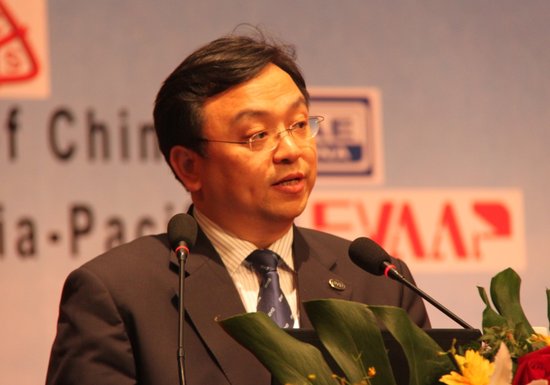
比亚迪总裁王传福
比亚迪已经连续4年参加北美车展
腾讯汽车:我特别想了解一下,比亚迪在中国也是很有特色的一个企业。在汽车这个方面,像北美车展,应该是连续几年了,只有比亚迪参展。
王传福 :第四年。
问:2007年开始?
答:2008年。
问:每年都是只有比亚迪?
答:2008年还有长丰、吉利他们,他们在楼下。我们第一年在地下室,第二年跑上来,很偏的位置,慢慢熬吧,熬到这个位置还算不错。日产有一年金融风暴不干了,日产和三菱今年想进来就没有摊位了。你不干的话,摊位被别人占了。如果明年我们不参展,这个摊位就给别人。如果我们明年还参展,我还是优先放在这里。
问:也就是展位一年比一年大了?
答:一年比一年大。今年还好,前两年气氛很差。去年通用破产,克莱斯勒也不行。通用在今年在中国赚了很多钱,近来了,摊位大,花钱也多了。
问:我昨天跟通用他们在一起采访了一下国际运营部的负责人,他讲,美国以外的市场已经占通用总的70%,很重要是来自中国,中国有200多万辆的销售。比亚迪这么多年参加北美车展,在北美的业务还是大。
答:今年看看小批量,我们有小批量在这边做一些测试。上个月我们在洛杉矶住环局,相当于中国的房产局,他们跟我们签了一个协议,帮我测试F3DM。他们也很愿意,他们也要做环保。昨天他们的头也来讲话,他还愿意测试我们的E6,买一些E6去做测试。因为美国是一个非常特殊的市场,我们必须先小批量地测试。
我们参加北美车展这是一个战略上的考虑,因为北美车展也是全球最大的市场之一。谁都可以放弃,我相信我们还是有机会。从第一年到现在,明年还是连续参展。我们在美国的策略,可能选择一些新能源车,美国传统汽车竞争也是非常激烈。而美国传统车领域,目前中国人的机会并不大。你光靠一些成本的优势,包括排放、安全,我们能达标的不一定说做的比别人好,传统车进来是有困难的。
新能源不一样,新能源大家刚刚起步,美国对新能源也开始慢慢热衷。2008年的时候,当时参展都很少谈(新能源车),我们参展带的新能源车,大家觉得很惊讶。但是现在每年都开始在提升,对新能源的认识也在改变。
今天应该说大家都能形成共识,新能源车是未来(的发展方向)。这里是全球人都在改变,改变成一个事实,电动车是一个未来。这个未来不会很遥远,也就三五年会有批量。现在大家都已经不再争论这个问题了,只是怎么干,什么时候走,什么时候出来。
比亚迪在电动车领域的优势越来越明显
问:说到这个问题,因为这两天看了一下底特律,比亚迪是中国企业里面对美国市场最有发言权的,因为参加四届了,它研究比较多,其他企业参加比较少。我是第一次来美国,就看底特律的路上到处都是大油耗的车。全球有一个共识,欧洲竞争很激烈,各种技术,各种车型。美国可能会有一些空间,但是市场就更加的糟糕,大油耗。它离新能源车,离低耗油的车,离比亚迪的产品会有多远?
答:我觉得应该很近了,美国企业现在已经参与了,当初只是外国企业参与可能还不一定。美国企业已经真正参与,像通用的Volt,好像福特也推出电动福克斯,明后年也会起来。克莱斯勒我相信也快,只要它观念变了,它就很快,就怕它观念不变。它观念一变的话,这些老牌厂,它要造电动车很容易的。他们零部件不像我们什么都自己做,他们都差不多了,弄一弄就可以了。主要是观念一变。
问:观念的一变,市场的变化就很快?
答:新市场是靠大家创造起来的,如果大家都做的话,市场就慢慢会形成的。比如说美国政府它有很多支持政策,现在联邦政府,联邦政府相当于我们中央政府,它已经通过一个减税的计划。你要买这个新能源车,可以减税,减7500美金。像我们E6减了七八千块钱,这个很优惠。你只要买了这个车以后,每年报税的时候就把这个税拿下来了,这个就相当于一个信号。美国政府高度支持新能源,企业又有产品,政府又有支持,这个市场就形成了。
问:说到这个产品的方面,因为我在巴黎车展上采访了戴姆勒负责技术的韦伯董事。韦伯讲到,他们自己的发展是多种新能源的技术和车型,但是对中国侧重发展电动车,他个人表示不太看好。正好我们比亚迪特长和优势在这个方面,您如何看在电动车上的优势和对其他新能源技术战略的一种规划?
答:我觉得这个优势现在来讲越来越明显了,因为我们做电动车的时间已经很长时间了。2008年我们卖双模车,包括现在卖得比较好。现在深圳一个月卖100多台,自从8月份国家有一个补助政策出台以后。南方电网也给了很多优惠,我们每卖一台双模车以后,他就给我们双模车的车主打电话,给他免费装两个充电装。他选择,一个是在他办公的场所,一个是在他住的场所,让我们车主感到受宠若惊。一个大央企主动给我们做,这个国家五中全会把新能源作为七大战略性行业之一有关,国家属于战略性的行业,所有的企业,特别是央企要积极跟进,这是非常正确的。这样的话,我们这些车主用起来,觉得非常便宜,而且给的电费是晚上0.24元。
问:普通的是多钱?
答:普通的电是0.6元到1元。晚上从11点到第二点早上7点,充电装是国家电网的。这个账目就很好算,我们一个双模车一百公里大概在15到20度电,乘上0.25元,才5块钱。百公里5块相当于0.6升的油,本来一百公里需要7升油,节约90%。你们可以到深圳调查一下,便宜的要命。这些慢慢会传播出来,我们觉得新能源,国家把它作为一个战略性的行业,国家的高度很高,央企,很多企业纷纷响应。地方政府也积极跟进,特别是深圳地区政府非常支持。从书记到市长亲自给予了很大的支持,我们的产品很珍惜,中国现在没有别的产品,就比亚迪的车,别的车没有。包括合资的也好,内资的都没有。我们认为如果说节省90%的概念,油价再涨一涨,这个产品的生命力会变得很强。现在产品贵一点,但是随着量的增加,产品价格会降下来。很快未来三五年,双模的价格会慢慢降下来。新能源汽车不只在中国,乃至全球仍然会越来越大。
大家也能看到油的价格今年已经突破每桶90美金了,假如没有金融风暴,现在已经是150美金以上。金融风暴之前石油就是150美金,金融风暴把它压到100美金以下。我相信未来三五年回到150美金一桶,这不是什么不可能。假如石油在150美金一桶,我想我们国内的油价可能在9块钱了。如果这样的话,油价一涨,国家又宣传战略性新型行业,这两边一挤兑,企业家一参与,市场就慢慢形成了。我们期待这个市场会形成,我们比亚迪已经做好准备了。
国家应当把发展电动车作为一个战略性的选择
问:几大国际车展里面,对其他几个车展比亚迪有什么样计划没有?
答:我们每年参加一个瑞士日内瓦车展,是欧洲的。美国的选择底特律车展,中国就是上海、北京。
问:欧洲那边是怎样一个考虑?
答:欧洲也是一样,我们也在慢慢学习,慢慢跟进了解这个市场。我们相信通过几年的持续参加,对当地的技术、市场、经销商、整个规则慢慢开始学习。我们还是以新能源做突破口,敲开这个门。我觉得传统车你要打开欧美市场很困难,当年日本进来的时候,日本、韩国人进来欧美市场,也是花了一番周折。光靠低价吸引不大,因此我觉得要有差异化的战术。比亚迪我们本身有一些优势,我们在新能源上面有我们的一些竞争力,因此我们想欧洲市场也是一样,用新能源来敲开它的门。
问:这方面欧洲也好,美国也好,刚才王总讲的是方法、战略和措施。有什么困难没有?
答:困难还好,你要传统车进来会有很多困难。首先媒体就不干了,都是虎视眈眈的。本来市场不够,市场在降,又来分一杯羹。我们做新能源他也不会说什么,反正新能源这个市场本来没有,是一个新的,也不是说抢你的饭吃,你也没有吃这一口饭。因为新能源他们现在也没有产品,或者刚刚才开始。
大家也知道新能源市场就跟轿子一样,你一个人抬不起这个轿子,四个人才能把轿子抬起来。只有做得人多了,政府重视了,充电设施齐备了,市场才能起来。因此谈不上我们和他们是竞争,也谈不上我们和他们竞争,谈不上。我们更需要每一家都搞一款产品出来,政府一看,你们都有产品了,我给你修充电设施,搞标准,搞一些辅的配套。
因此我觉得新能源来目前来说还不是竞争的问题,我们反而希望大家一块参与,恨不得每家都有车出来。大家一块把市场做大,市场做大了,每家都能分一杯羹。
问:刚才提到巴黎车展,我采访了戴姆勒,他们都谈到与比亚迪的合作。他们表示做得很好,并且对未来有很高的期望。这段时间有没有新的进展可以分享给我们?
答:现在进展都挺好的,正如他们说得一样,我们双方都很满意,对各自做的工作都比较支持。对各自取得的成果也比较满意,我们也很看好未来。
问:昨天您在演讲中提出来,不仅仅是一个车,而是一套解决方案。我昨天也收到一个很棒的礼物,比亚迪的小灯泡,说是照明方案。比亚迪想给美国市场提供的这套解决方案是个什么东西?
答:我们一直讲三大梦想,化石能源已经到了人类必须要思考的问题。化石能源,包括煤都属于化石能源。化石能源人类要开始思考,未来三五年,比如太阳能应该做一个可再生能源,应该大规模进入这个市场。但是现在使用太阳能,包括风能中国已经大规模使用了。太阳能使用的障碍主要是属于成本问题,太阳能发电的价格和煤发电的价格是一样的话,你想太阳能市场会爆炸似的的增长,等到那时候人类会毫不犹豫地用太阳能。第一,太阳能用不完,地球没了,太阳还是照样有的。第二,太阳不产生温室气体,我们用煤会产生二氧化碳。它不产生二氧化碳,最清洁。这些能源要使用的话,可以解决人类未来长期的……没有后顾之忧了,这是人类必须考虑的问题。
而且现在我认为发展速度很快,我们已经看到这个速度很快。太阳能市场每年增加的速度很高,因此我们推出了太阳能产品,包括美国、欧洲,我们开始在行销,我们也往美国卖。我们希望太阳能或者可再生产生的电,通过一定的存储,再形成给汽车充电,这样能够实现汽车真正的零排放,而不是说汽车再用煤发出的电,汽车是零排放了,火电站还在……这是我们一个梦想。
解决这个方案里面,我们又分一些新的方案。比如说我们想推出一个城市绿色化,或者城市公交电动化的解决方案。大家可以简单地分析一个数据,现在我们在中国也好,美国也好,欧洲也好,都是一样。公交车一个是大巴,一个是出租车,公交车的话,数量并不大,占我们中国的车辆1.5%。
50万台大巴,20万台出租车,中国的机动车方面大概9000万台。100多万除上一个亿,就是1.5。但是耗油量是多少,是25%。中国每一百吨油,就样25吨油给谁干掉呢?大巴和出租车。像你买一个1.6排量的小轿车,这个轿车如果做出租车的话,排量是一样的,但是出租车它一天24跑,它一天是两班。车不停,人停。白班一个人开,晚班又换一个人开。它的耗油量是你的十倍。实际上排量是一样的,大巴更不得了,一个大巴相当于30台私家车的耗油量。1.5%的数量,它耗油是25%。
如果一个企业家他有社会责任的话,后者一个企业家具备这些技术的话,我们要优先发展公交。如果公交要是电动化的,把这1.5%的车,电动车它是要逐步逐步,如果这一块要先进行电动化的,它一下省25%的油,省了25%的油所来带的排放。这种责任让企业家更应该首先做。如果有这个技术,首先发展公交电动化。
从(21:26不清楚)公交电动化了,政府有话语权了。私家车政府有话语权吗,有,但是不大。最多给点补助,他不敢说你必须买。公交车可以,比如说深圳公交大巴,政府说换就换,因为都是国家的。
假如国家把它作为一个战略性的高度,这个意义非常大。这里有社会责任在里面,企业家的责任在里面,也有咱们国家的利益在里面。因此这件事是可以更容易做成,一旦做成的话,也是功在当代,利在千秋。比亚迪我们有电池的技术,也有电动车整体的解决方案,包括公交大巴的解决方案或者出租车的解决方案。
现在我们把这个方案打包,形成一个整套的解决方案。比亚迪不仅仅做一个出租车,也不只是做大巴,两个都做,在这一块我们应该是优先去选择。但是比亚迪也不会放弃我们在私家车里面,比如我们F3DM还是大量提供这个产品供到深圳。我们明年上半年会把E6这个车除了出租车供货以外,我们还给私家车提供。私家车就靠每个人了,有一些补助。
问:这种解决方案在美国和中国的可行性会不会有些不同?
答:中国政府的话语权很大,美国政府没有钱,政府都很穷的,而且政府也没有权。一个是没钱,一个是没权。我们和洛杉矶政府关系非常好,他们特别想买我们的车,他们没钱,他只能租。他买车的程序要通过议会,买了几部车整半天。中国政府你知道,一句话。
问:相对来说在中国的可行性更高一些?
答:更高一些,但是美国也想找一些商业模式。比如说出租,我们找一个第三方买下来,它再租给房地产局,或者洛杉矶市公交所。租给它,它的批文就好了。中国政府也有这个问题,比如说指标,但是新能源车现在不属于指标,它有一个什么标准。政府你今年只能买三部车,只能买三部车。但是出就没有这个限制了,它有一些窍门。但是美国政府确实比较穷,我们还有一些技巧。利用政府它暂时想做这件事,但是它没有钱,或者它没有能力做,或者没有流程的话,我们再想出一些新的商业模式,通过第三方购买,再租给想用车的机关。这种方式又解决了流程问题,又可以解决我们车大量使用,使环境真正能够环保。
中国现在一年卖1800万部车,未来5000万部不算什么遥远了
问:刚才这样的解决方案,包括进军美国市场、欧洲市场,我在想,通用它是一个很大的跨国公司,它的海外业务占的比较也很高。比亚迪这样去做它的海外业务,对这个海外业务的期望值有多高?它想要做成一个跨国公司吗?
答:你看中国的很多产品都是出口的,美国人也经常用中国的产品。你看美国的商店有百分之七八十都是中国出口的。特别像好的电气电子大部分都是从中国来的。汽车也不例外。
问:国产出口还是到未来的本地生产?
答:首先会在中国做,到时候看一些政治上的问题,那是另外一个事情。我觉得中国人要把别的产品也能做得好,我相信汽车也不例外。但是汽车明显参与的比较少,它不像小家电做了很多,所以应该是有机会。美国确实市场很大。作为一个中国企业,我们也应该在这里去分一杯羹,像美国这三大公司,它一点都不惊讶。他们在中国分享了中国汽车市场的增长,他们也会接纳一个来自于中国,对他们曾经产生过很多利润的地方的一个企业,卖到美国的一些车,政治上不会有任何不对的地方,可能不对的韩国。
问:韩国很难?
答:韩国它没有市场让美国人去占有,中国不一样。你看美国人在中国赚了多少钱,中国企业到美国卖几部车子,至少媒体不会说什么。
问:美国、欧洲这个业务会做得很大吗?
答:现在很难去估计,我相信我们力争会做大。也是一个重要的力量,而且我觉得在环保问题上讲,在欧美还是有一致的方案,他们都会支持,也会坚持环保车会受到一些鼓励。
问:我感觉王总越来越低调了,因为咱比亚迪是有一个目标的。一个很公开的目标,2015中国第一,2025全球第一。现在这个目标还在控制中?
答:对。你在中国做得很大的话,就可以做到全球第一了。你看现在已经快1800万部,未来5000万部不算什么遥远了。
问:您会相信5000万这个数字吗?
答:政府要是不管制的话,应该是很容易的。但是政府要是搞一些限车会有一些困难,要是像以前放开卖车的话,老百姓一个家庭一部车有什么困难,一个人一部车也不是什么梦想。一个家庭一部车就4亿部车,一年按照20%,你算吧8000万,这不是什么梦想。我们做手机走过来的,我们最早做手机的时候,当时在1997年、1998年,我们觉得手机超过美国人不可思议,中国人说自行车可以超过美国,棉花可以超过美国,手机不可能。手机是高科技产品,怎么能超过美国,当时没人相信,后来几年就把美国超过去了。
我们当时预测的时候,没人信。你说中国的自行车可以超过全球,棉花可以超过全球,你手机怎么能超过全球呢?高科技产品怎么能超过全球呢,现在不但超过,还是美国的好几倍。汽车也很快,你算吧,普通老百姓一个家庭一部车,也不是什么(难事)。以前是梦想,现在是梦想吗,也就是三五年的事。
问:我们腾讯网有很多,我做得的是购车的这个部分。我会感觉新能源这个部分,包括比亚迪的参展,包括新能源的车离普通用户还是比较遥远。我感觉好像是两层级的一个概念,新能源解决方案的汽车和普通消费者的购车是不同的。那在中国市场,比如刚才谈到5000万,会是我们其他普通轿车造成的,还是新能源在里面会……
答:新能源车如果做便宜,也不会很贵,跟普通车一样的,价格不会有什么差异。像我们现在的这个双模的方案,政府补助8万块钱,和普通车一样。你一百公里才花5块钱,里面的动力比较好。因为电动车的动力好,加速比一般的车要好。你如果把这个成本将下来,卖的就多了。
问:深圳我们看来比较成功的一个城市,您会认为这种城市未来的可复制性会在多长时间完成?
答:用不了多长时间,现在国家不是补8万嘛,把它降8万下来不就行了。
问:这个可以做到吗?
答:可以做到,也就是三五年的时间。国家政策会慢慢退出去了,国家短期内可以补助一下。
问:因为都是深圳的兄弟企业,我们会祝比亚迪越走越好。回头我们在网上做一些报道,您会给我们腾讯网友寄语点什么?
答:像我们这次参展感觉到,中国的力量在强大,大家都在谈论中国市场。中国现在这个地位与日俱增,祖国的繁荣昌盛。大家都在谈论中国市场,中国强大,但没有一个像样的企业,或者没有能够在国际上像丰田一样,我们觉得有愧,我们还是做得不好。我们要和祖国同名的话,应该出一些好的企业,大家觉得中国好,不仅市场大,企业也厉害,产品也厉害。这也是中国人应有的名分吧,我们也要做努力。
比亚迪夏治冰:2011车市保持10%至15%增速
嘉宾档案
比亚迪汽车销售公司总经理。年轻有为、敢打敢拼,非汽车行业科班出身的他,在汽车界叱咤风云,比亚迪汽车在他的营销和推广下,一度成为中国车市增长最快的企业。
2011增速可能高于10%—15%
华西都市报:您对2011行业大势有怎样的预测?
夏治冰:我注意到行业普遍预测今年汽车市场将保持10%—15%的增长速度,我赞同这个观点,甚至还会更快。这首先基于中国汽车市场存在的刚性需求。其次,二线城市汽车市场的需求依然旺盛,三四线城市市场也逐渐成熟,这些地区将成为未来拉动中国汽车市场发展的最重要力量。此外,虽然购置税等政策退出,但是针对1.6升排量及以下车型的3000元节能惠民补贴政策仍会持续,仍会促进小排量汽车的消费。
倾情电动车让中国力量领跑世界
华西都市报:对汽车行业的新技术、新趋势有什么看法?
夏治冰:在传统汽车领域,可变气门技术和增压技术等节能发动机技术将会得到进一步的发展和普及。在新能源汽车领域,电动汽车作为最成熟的新能源汽车技术,其发展日益受到各国政府和企业的重视。作为全球领先的新能源汽车企业,比亚迪将义不容辞地投入到中国电动汽车产业的发展壮大中,让中国力量领跑世界。
华西都市报:比亚迪公司2011年的规划和打法?
夏治冰:2011年,比亚迪将继续坚持品牌战略,推动传统燃油汽车和电动汽车的共同发展。在产品层面,比亚迪将推出精品车型G3R、G6、S6。在
电动汽车领域,比亚迪除了加强电动汽车技术的研发创新外,还将主推“城市公共交通电动化解决方案”:用比亚迪的纯电动轿车e6和纯电动大巴K9替代现有的城市出租车和公交大巴,从而率先促进纯电动汽车在公共用车市场的推广和普及。
华西都市报:2011年您个人对事业的梦想?
夏治冰:2011年,我们将继续加强团队建设,完善品质、售后服务等各项细节,并在适当的时候推出我们在汽车研究领域的新技术成果。我的2011梦想就是继续为打造优秀的汽车品牌而坚持不懈地努力。
Friday, January 14, 2011
Storing Solar and Wind Power Is a Base-Load Conundrum
Here in Colorado we have an abundance of both sun and wind, so it's no surprise that our stateRenewable Portfolio Standard was recently raised to 30 percent by the year 2020, from the 10 percent that was enacted in 2004 by constitutional amendment.
So with the excellent solar and wind resources here, why not increase our RPS to 50 percent, 80 percent or even 100 percent?
The problem is “base load.” That's the minimum amount of power that must be available from the utility at all times, and it changes with daily and hourly predictions based on historical data and current trends.
Unfortunately, the sun isn't always shining and the wind isn't always blowing, so 24/7/365 energy sources are always required.
Hydroelectric generation is a renewable base-load option in some areas, but Colorado doesn't have much of a hydro resource. Coal- and nuclear-fired power plants are the most common base-load generation sources throughout the United States, because they are cheap to operate and consume inexpensive fuel.
When energy needs spike (such as during a hot summer day when everyone turns on their air conditioners, or on a cold winter night when electric heaters are running full blast) utilities turn to “peaking” generation systems that can be spun up and generating within minutes.
You can't just flip the “on” switch to get a coal or nuclear generator working — they take hours or even days to fire up from cold to producing energy. Hydroelectric plant operators can quickly increase the water flow and the number of generators operating, but only if there's enough water available at the time. In most areas, natural gas turbines are used to handle peaking loads, but the fuel is too expensive to use for providing constant base-load capacity.
Energy Storage
The answer to using solar or wind for utility base load seems obvious. Just store any excess energy produced and release it when the renewables are not generating, just like in an off-grid home. All you need is a really big battery! Therein lies the rub.
Until recently, America's biggest battery was located in Fairbanks, Alaska. Called “BESS” (Battery Electric Storage System), it was built and installed by the ABB Group for the Golden Valley Electrical Association in 2003 at a cost of $35 million. This half-acre, 1,435-ton battery bank provides 27 megawatts of base-load backup power for GVEA's 90,000 customers in the event that grid power from Anchorage is interrupted. Unfortunately, BESS can only do that for 15 minutes — just long enough to get Fairbanks' diesel backup generators spun up and on line.
The town of Presidio, Texas, also had a problem — frequent blackouts due to the now-undersized 1940s-vintage transmission lines still feeding the town. Extra energy could be purchased from Mexico, but with hours-long blackouts common, changes were made. In April 2010, Electric Transmission Texas put “BOB” (Big Ol' Battery) into commission. BOB weighs over 320 tons, costs about $25 million, and can provide 4 megawatts of base-load power to Presidio for about eight hours.

PHOTO COURTESY OF NASA
One space-age storage solution is using
flywheels that spin inside chambers kept at
a near-vacuum to reduce friction, above.
Although that remains a very high-tech and
expensive possibility on a utility scale for
base-load storage, there are hopes for its
usefulness in the future.
Those battery numbers are all pretty depressing when viewed in a cost-vs.-storage capacity perspective. Right now, the only other real storage option on a utility scale is hydroelectric — excess generation powers giant pumps that move massive amounts of water up a steep hill to a large reservoir, to be released through hydro turbines to generate electricity again when peaking generation is needed. The problem with this method is that the efficiency is dismal, with close to 70 percent of the incoming energy wasted.
Battery technology is rapidly improving, thanks in part to greater public interest in plug-in electric vehicles. BOB in Texas employs new technology, sodium-sulphur cells, instead of the more traditional nickel-cadmium cells used in BESS. But the cost per kilowatt-hour of electrochemical energy storage remains tremendously high, especially when compared to current methods that store the most amount of energy for the least cost — a lump of coal, uranium pellets, or a barrel of oil. Are there other options?
The future
Certain recent industrial-scale solar energy projects employ some energy storage. These solar thermal plants use mirrors to heat molten salts, which are used to flash water into steam and power conventional steam turbine generators. The salts hold heat for quite some time, and the turbines continue to run after the sun sets. While this represents great progress, it's still tricky. The storage part of the system is far more complex and expensive than the generation side, and heat cannot be stored long enough to provide a source of base-load capacity.
Of course hydrogen production, storage and generation have been touted for many years, and these might well be our future for energy storage. The “hydrogen economy” hype of the past few years has died down, though, mostly because hydrogen is notoriously difficult and inefficient to produce, store and use. It can escape through the tiniest gaps, it turns regular steel unsafely brittle and is explosive when mixed in the right proportion with air. These problems will all be solved — eventually — but at great cost and over a long time frame.
Compressed air energy storage on a large scale has been discussed too, but suffers similar technology cost and efficiency problems.
Flywheel energy storage has recently received media attention, and with good reason. Spin a heavy wheel up to tens of thousands of RPM in a near vacuum to reduce air friction and float it on magnetic levitation bearings, and you have a formidable energy storage system. But flywheel storage remains a very high-tech and expensive possibility on a utility scale for base-load storage. It's currently used only in specialized applications.
A better mousetrap?
As I sit here 11 miles off the grid and gaze at my (literally) ton of home backup batteries, the thought crosses my mind that I'm looking at 1915-era technology — and that it's still the most efficient, cost-effective choice for me. And when I float in Pinewood Reservoir with my fly rod each summer, it occurs to me that this massive, inefficient pump, water storage and hydro turbine system is about the most efficient and cost-effective way for the utility to store its energy, too.
It's a good bet that future utility-scale, renewable energy storage systems will use some variation of the methods we have already imagined. Scientists understand the basic laws of physics pretty well these days. The winner won't be the company that invents the most high-tech and efficient energy storage mousetrap — it will be the company that builds the one that stores the most energy at the lowest cost.
Wednesday, January 12, 2011
BYD Exec Reveals U.S. Strategy
Stella Li:
Stella Li, BYD's senior vice president, said in an interview in Shenzhen, China, that the company drove dealers in China hard to attain its unrealistic sales goals, alienating some of them. "Now, we need to slow down a bit and adjust our strategy," she said.
To start with, BYD this year is forecasting a modest 10% increase to about 550,000 vehicles, more or less on par with the 10% to 15% growth seen for the overall China market by most auto makers and forecasting companies.
According to Mr. Wang and Ms. Li, one main cause was the slide in BYD car quality and appeal, at least as they are perceived by consumers. Said Mr. Wang: "Over the next few years, we are going to slow down our growth pace and focus on the quality and design of our product."
"We're starting to watch dealer inventory cycle very closely now" so that BYD doesn't have to require dealers to carry large stock, Ms. Li said. "We do not want repeat this kind of mistake in the future."
BYD critics also point to the company's lack of profit as a major cause for concern. When I discussed this with Mr. Lin, he said it was not the right time to focus on profit. BYD had aimed to get its product out in the market and demonstrate its durability. There have been a number of deals which the company has struck with local Chinese governments for taxis, buses, and police cars. These weren't aimed to be huge money-makers, he said, but to show future consumers how well the car performs from heavy users.
There has been much in the news lately about Beijing's restrictions on vehicle licenses in the capital to control pollution and congestion. Recent IPO and Beijing car dealer Lentuo International(LAS_) has been hit hard by this news as investors have been concerned that there will be fewer auto sales locally as a result. Mr. Lin said that Shanghai had had such restrictions for a while and the Chinese auto market has kept growing. The big opportunity, he said, for all auto companies is growth outside the major Chinese cities.
Wang Chuan Fu:
BYD will slow new-product cycles and take more time to buff the quality and styling of new cars, BYD Chairman and founder Wang Chuanfu said in an interview on the sidelines of the Detroit auto show.
BYD also plans to slash the number of dealers, which totaled about 1,000 at the end of last year, by 5% to get rid of inexperienced stores, according to Mr. Wang. The move is also hoped to improve per-store revenue and profit.
Moreover, BYD plans to do a better job forecasting demand and focus more on "quality of sales" rather than "obsessing on market share," the BYD chief said.
"In the past few years, we made a mistake of focusing on growth too much," said Mr. Wang. For example, BYD was too optimistic about Chinese consumers' appetite for its cars, and "we expanded our distribution channel too quickly and ended up focusing on the quantity rather than the quality of the dealer network," he said. The result: BYD's sales network became bloated with underperforming dealers.
Mr. Wang said BYD in early 2010 had a flood of dealer applicants, and the number of its stores was to hit 1,200. When sales began cooling midyear last year, some of those applicants withdrew, while others defected to other brands. In total, Mr. Wang believes about 100 dealers left BYD because of the turmoil.
Michael Austin:
At this year's North American International Auto Show, Michael Austin, the VP of BYD America, told Benzinga how Buffett came to the company, and why he chose BYD over another automaker.
"I would tell you, it is that BYD wasn't like a Detroit auto company," Austin said. "We weren't. We weren't coming out of the same tub. We weren't coming to compete with Kia or Hyundai. We weren't coming here to compete on price. We had something completely different. Even our vision was not about making EVs and flooding the market with EVs. It wasn't even that vision."
Austin credits BYD's holistic vision - which includes putting solar panels on the roof of every home and adding solar panels to every parking lot - as being another major feature that attracted Buffett to the company.
"I think he was really, really keen on - even though he didn't understand the technology, he caught the vision," Austin continued. "[This is] a Chinese company that's thinking about the environment, and it's thinking about how to change China. And certainly Warren said, 'I need that in the U.S.' BYD wasn't convinced that he needed it in the U.S."
But Buffett didn't give up. "Warren pushed them a lot," Austin said. "Because the truth is, the market is in China. The market is in India next. It's never going to be in the U.S. We're going to sell, what, 10 to 15 million vehicles here. They sold 15 million in China alone! They passed the U.S. market two years ago."
To be clear, Austin says that the whole Chinese market is at 15 million automobiles a year, whereas the U.S. market is only at 11 million. In the prior year, the U.S. market was at 9 million, whereas the Chinese market had swelled to 13.
"What's the penetration for vehicle usage in the United States?" Austin questions. "Ninety-eight percent. What's the penetration in China? Six."
With 1.6 billion people, there's a lot of room for growth. "The middle class has reached 30% - 30% wants a car," Austin insists. "They don't have a dream of owning a home. Their dream is mobile. Their dream is getting a car so they can be mobile. And they'll do one car per family, that's still the goal. But one car per middle-class family is still 320 million cars yet to be sold. It would take me 80 years to sell 320 million cars in the U.S. and Europe put together. So China's the market."
But where does that leave America? Can Detroit automakers make a comeback?
"I think Detroit has the willpower," Austin said. "Detroit certainly has the manpower. They have the resources. They don't need new leadership, they just need brave leadership. And it takes some guts to say, 'I'm gonna go first in the market,' like GM (NYSE: GM) did with the EV1. You know? And it takes some guts to say, 'I'm gonna crush all those EV1s.'"
Finally, when asked if he believed that David Sokol would be Buffett's successor, Austin said that he didn't need to say that himself. "It's been published that he's a likely candidate," Austin said. "And you know, only Warren and Charlie - Charlie seems to know more about his successor than Warren knows. [Laughs] It's true! You should ask him."
References:
After Lousy 2010, BYD Has New Plan
BYD Auto Targets U.S. Debut for 2012
BYD Auto Tells Benzinga Why Warren Buffett Invested In The Automaker
BYD's Presentation at 2011 Detroit Auto Show
Monday, January 10, 2011
Nobel Prize Winner (Zhores Ivanovich Alferov) visits BYD
1月7日上午,诺贝尔物理学奖获得者、俄罗斯科学研究院院长、圣彼得堡大学校长若列斯·伊·阿尔费罗夫院士携其子——圣彼得堡大学创新部主任伊万·若·阿尔费罗夫访问了比亚迪坪山总部,比亚迪中央研究院院长宫清等接待了他们。
阿尔费罗夫院士一行在坪山展厅参观时对比亚迪产业规模大为惊叹,同时也对比亚迪“技术为王,创新为本”的理念极为赞同,“Great company”不时地从阿尔费罗夫院士的口中传出。阿尔费罗夫院士主要研究的领域与比亚迪新能源产业联系紧密,参观期间提出了很多有关公司新能源产业尤其是LED未来发展的独到见解。阿尔费罗夫院士对比亚迪自主研发、生产的F3DM大为赞赏,试驾结束后竖起大拇指,连连称赞“very good”。随后,双方对半导体及新能源目前已有的技术及未来可发展趋势进行了深刻、热烈的讨论。阿尔费罗夫院士表示比亚迪是他少见的、能与自己进行如此深刻技术交流的企业。阿尔费罗夫院士最后说道:“比亚迪将来一定能成为世界新能源的领军企业!”

Other Updates
Shenzhen starts using K9 electric bus
1月6日,比亚迪纯电动大巴K9在深圳福田区202路公交线(福田枢纽-航母世界)正式投入载客试运营,最低只花2元即可享受纯电动公交的无碳及舒适。据了解,本次比亚迪为深圳巴士集团提供了两台K9作为试运营车,到大运会时K9投运规模将扩大到200台。从现在开始两位“绿巨人”就将正式投身“绿色事业”,与兄弟车F3DM、e6一起为未来交通电动化努力“奋斗”了。
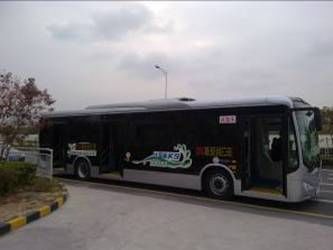 K9试运营
K9试运营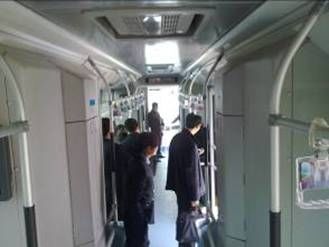 试运营K9车内
试运营K9车内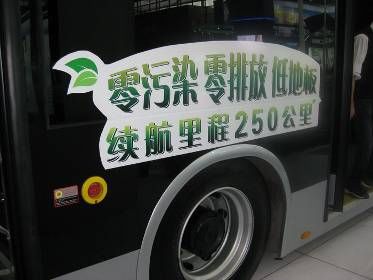 节能环保 经济实惠
节能环保 经济实惠 城市中大量使用公交车有助于缓解拥堵,但传统公交车也是城市污染的大户,一部公交车的能耗及排污量相当于30辆私家车,10辆出租车,而用纯电动大巴作公交车既能缓解拥堵又解决了城市污染问题。
本次在深圳投入运营的比亚迪K9完全使用电能,无污染、无噪音、真正实现了“0”尾气排放。经测算,比亚迪K9在开空调的情况下,每百公里耗电为120度,即便工业用电价格提高到6角一度,K9运营一百公里只花费约72元人民币。按大巴一年运营353天,日行距离250公里计算,K9年耗电约6.4万元。而普通的燃油大巴开空调行驶百公里约耗油40升,以现今的油价计算,一年的油钱是22.1万元。也就是说,如果用电动大巴替代燃油大巴,一年的油费就可节省15.7万,燃料消耗成本还不到同类燃油车的1/3,环保又经济。
 舒适便捷 绿色交通
舒适便捷 绿色交通纯电动大巴K9是比亚迪通过电池技术优势,结合整体设计优势打造出的一款适合城市的交通工具。K9搭载的正是比亚迪自主研发生产的铁电池,其优良性能己在比亚迪F3DM、e6等车型上得到充分验证。经测试,K9一次充电综合工况续驶里程超过250公里,如果不开空调可以达到300公里以上,利用公交总站的专业充电设施快充,半小时即可充满50%的电量,而安装于车顶的太阳能电池板,在行驶过程中也可提供辅助续航动力、为动力电池充电。向大巴司机了解到,本次运营的两台K9将于总站南方电网福田电动汽车充电站补充能源,单台车一次充电可行驶3个来回。
纯电动大巴K9独特的人性化设计也将给乘客带来全新的温馨感受。K9采用了全通道低地板、一级踏步设计加三乘客门结构,乘客上下车将更加便利,即使是老人小孩也能轻松一步踏入,后车门处还专门设置了一块折叠金属,平时置于车内,通过把手拉起后可翻出车外,在车门与公交站台之间搭出一个不足30°的小坡,方便轮椅、婴儿车、拉杆箱等的上下。K9的载客区借鉴了地铁设计,车身两边分别有一排折叠椅,相较于一般公交的固定座椅,对车内空间的利用更为灵活,使得乘坐更加舒适。
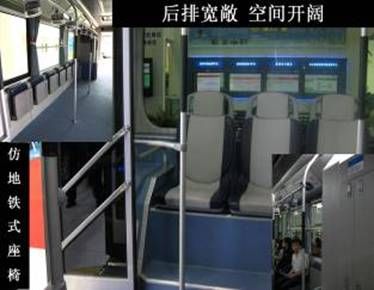 仿地铁式座椅
仿地铁式座椅 据了解,目前投入运营的两台比亚迪K9是深圳地区首批运营的纯电动公交大巴。此前,这位“新能源领导者”的双模电动F3DM已面向个人销售,纯电动车e6作为出租车在深圳投入规模化运营,目前累计运行里程已突破150万公里,而电动大巴K9上路试运营则正式宣告“绿色交通时代”已向大众走来。
Thursday, January 6, 2011
Daimler-BYD GOLF
GOLF = Green, Oxygen, Light, Friendship












Subscribe to:
Posts (Atom)


